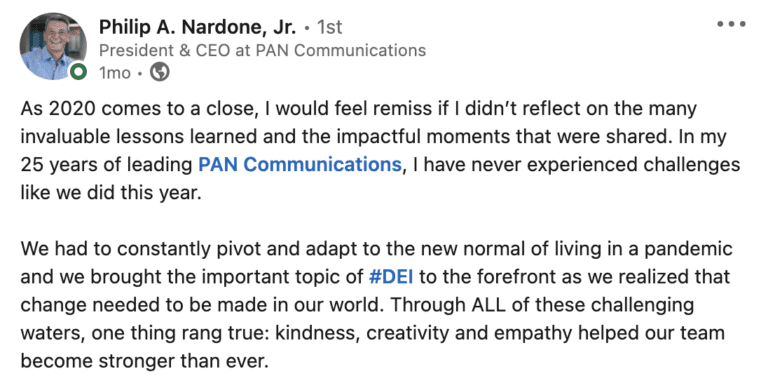PAN’s Issues Response Team (IRT) is comprised of experts from our Media, Integrated Marketing, Creative and Content teams, to help our clients navigate sensitive issues with a holistic view of internal and external messaging. The below blog is the first in an upcoming issues response content series.
The last year forced companies to confront crisis in a way never before seen. The world dealt us more challenges than perhaps we were used to handling, starting with a global pandemic that impacted businesses and, more importantly, their people.
We had to rethink the way business is done and how we interact with our teams. How we nurture culture, talk about mental health and create space between work and home when the physical boundaries were erased overnight.
We saw the murder of George Floyd and the national spotlight on the Black Lives Matter movement. We lived through an election that surfaced differing points of view and emotions.
We watched tech industry platforms speak up about free speech and what role technology plays in these conversations.
“All of these moments forced companies to rethink not only how to thoughtfully engage with crises as they develop in real time, but offer meaningful value to the conversation.”
All of these moments forced companies to rethink not only how to thoughtfully engage with crises as they develop in real time, but offer meaningful value to the conversation. This was also the catalyst to us rethinking the way we help counsel our clients through these issues. Out of that, our Issues Response Team (IRT) was born.
Enter: PAN’s Issues Response Team
To appropriately counsel our clients, we created a team that would give a 360-degree view of an issue, considering key factors like audiences impacted, appropriate messaging, tone of content (both in copy and visuals), channels and timing of communication.
Our Issues Response Team is composed of experts from our specialty areas: Teams Media, Content, Creative, Integrated Marketing and PANid (the group that leads our diversity and inclusion efforts at PAN). When issues are flagged (for example, Blackout Tuesday), this team comes together to provide counsel to our teams and clients on best practices for navigating their communications.
For more tips on how to approach sensitive issues, read “5 Childhood Lessons That Apply to Crisis Communications.”
The IRT also has us taking a closer look at how to best serve our clients when it comes to Issues Response – how do we bring our PAN methodology, best practices and expertise to each of these situations to help our clients navigate these scenarios? As we listen, learn and help guide our clients with their Issues Response, we’re looking at our current and future service offerings to always bring value-add to the brands that we work with.
Here’s a sneak peek into the process that our team uses – and what your company should be thinking about – in these moments for determining when, where, how (and if!) you want to speak up.

8 Steps for Your Issues Response Team to Consider
- STEP ONE: Consider the Issue. What impact does the issue have on your business? Is it a direct impact – affecting your clients, partners and employees? Does the issue support – or contradict – your company’s mission, vision, values or code of ethics? Does the issue align to something your company has spoken out on before? And do you have something unique and insightful to share that can help add to and educate around the conversation? This process can help determine what issues demand a company response.
- STEP TWO: Consider Your Audiences. You decided you have something to say – now to whom? Much like the issue itself, you want to dissect the audiences you should consider addressing. Consider the impact on your employees, customers, partners, Board of Directors, investors and the media. Determine which ones need to hear from you on the issue. If it’s an issue that’s directly impacting your business and customers (e.g., a security breach), the answer is likely that they all need to hear from you, with different degrees of context and urgency.
- STEP THREE: Develop Your Key Messages. What are three key messages you want to communicate to your audiences? While each audience will get a varying degree of information based on what matters most to them, the topline messages should be consistent. That reinforces company alignment and clarity. Your message may be one simple statement that all of your audiences receive, or it could be a statement followed by audience-specific FAQs (for customers, employees and the media). Remember that your messages – or statement – should provide clarity, consistency, empathy and authenticity.
- STEP FOUR: Evaluate Communications Channels. Determine where and how you will use your communications channels to get your message out. Consider your website, blog, email and social channels (LinkedIn, Twitter, Facebook and Instagram). This is where you can also consider that halting communications on specific channels is also a message (for example, determining that you’re going to hold organic social posts for a day because it feels self-serving in light of the issue). And don’t forget the visual aspect of how you’ll deliver your message. The images you use, their look and feel, also carry meaning.
- STEP FIVE: Determine Your Spokesperson/People. Who is going to carry your message? Is it the CEO? In some cases, it might be varied. You might opt for your CEO to be the outward facing spokesperson for your blog, social channels and in media; while your VP of Customer Success may own the customer communication; and your head of HR may own the internal communication. It’s what makes the most sense for your business – but remember that message consistency is key!
- STEP SIX: Discuss Timing, Process and Roles. You want to align around who you’re communicating to when, and what the agreed upon follow-up cadence looks like. If it’s an ongoing issue and not just a one-time statement, ensure you have a process and owners for fielding follow-up questions (from customers, partners, the media and employees) that might arise via email or on social.
- STEP SEVEN: Get Real. There is no better time than when you’re facing an issue to get real. The good rules of transparency, integrity, honesty and authenticity are key to building trust with your core audiences. How you respond to an issue often creates a more lasting impression of your company than the issue itself.
- STEP EIGHT: Assess and Audit. Each issues response offers an opportunity to evaluate and improve the way you engage with your audience. How did your key audiences receive and perceive your message? Was it positive, negative, neutral? Was there a channel or audience you failed to consider? Taking the time to assess, audit and learn from these issues will bring you a step closer to the right way to engage with your audience.
If your team isn’t already talking issues response, there’s no better time than the present to start a dialogue. If there’s one thing we can predict, it’s that our world is unpredictable. You must be ready to respond to issues in minutes.
What kind of voice do you want your company to have this year? Do you have a team that is equipped with the right tools, knowledge and process to approach these kinds of issues?
Stay tuned for more insights from PAN’s Issues Response Team in the months to come.





